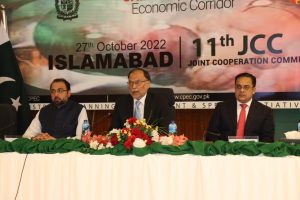Pakistan’s Prime Minister Shehbaz Sharif will visit China on November 1-2, when he will meet Chinese President Xi Jinping. This is a significant meeting; it is Sharif’s first visit to China since becoming prime minister and, in a signal of the importance of the Sino-Pakistani partnership, Sharif will become the first foreign head of government to meet the Chinese president after the latter secured an unprecedented third term as the General Secretary of the ruling Chinese Communist Party last week.
Sharif’s visit to China is very important for Pakistan; the Pakistani prime minister will be accompanied by a high-level delegation that includes Foreign Minister Bilawal Bhutto Zardari.
The Pakistan government will be hoping that several China-Pakistan Economic Corridor (CPEC) projects that have been pending for years will get a boost following the Sharif-Xi meeting. Foremost among these projects is the $10 billion Karachi to Peshawar railway project.
Last week, the Sino-Pakistan Joint Coordination Committee (JCC) agreed to start the Main Line (ML)-1 project for the construction of the Karachi to Peshawar rail line. The two sides also agreed to explore new avenues in the mining sector and to expand cooperation in the information technology sector. Memorandums of understanding and agreements relating to CPEC projects are expected to be signed during Sharif’s visit to Beijing.
Importantly, the Pakistani delegation is expected to request the Chinese government to roll over deposits and reschedule debts worth some $27 billion. Whether Xi will agree to Sharif’s requests remains to be seen.
More than any other country, China has been pouring money into low and middle-income countries. However, as per World Bank statistics, the volume of these loans has fallen by around 40 percent in recent years. Despite these cuts, Pakistan remains one of the top recipients of Chinese loans. This is mainly because of CPEC, a flagship project of China’s Belt and Road Initiative (BRI).
CPEC is an important component of China’s efforts to boost its energy and economic security. One of the world’s largest consumers of energy, it relies heavily on importing oil to meet its needs. More than 80 percent of this oil comes to China through sea routes. One of the most important sea routes for these imports is the Strait of Malacca. However, Beijing has been apprehensive that rival powers will block its access to this strategic waterway in the event of war, which would have a crippling impact on the Chinese economy. This “Malacca dilemma” drove China to look for alternative sea routes for its imports to China. And this is where its interest in CPEC emerged.
In addition to reducing Chinese dependence on the Strait of Malacca and the South China Sea, CPEC enables Chinese imports from the Persian Gulf and Africa to reach China’s western provinces through a shorter distance via Pakistan’s Gwadar port than the longer sea and overland journey via China’s east coast.
However, it has not been easy for China to realize these plans. Chinese funding for CPEC projects has been slowing down in recent years.
While the security situation especially in Gwadar Port and Balochistan has always been worrying, this did not deter the Chinese from investing in CPEC. So why is China hesitating to invest more in Pakistan now? There are two possible reasons: one is the already huge debt that Pakistan has been unable to repay; the other is China’s economic situation.
While Pakistan is eyeing continued and intensified bilateral cooperation with China and the implementation of CPEC projects, there are concerns that Islamabad may be debt-trapped. These concerns are not without basis. According to a report by the International Monetary Fund (IMF), Pakistan’s debt owed to China is three times more than what it owes the IMF. This is also more than what it owes the World Bank or the Asian Development Bank.
Huge international debts and current inflation rates ranging from 23 percent to 30 percent have left it in the grip of an economic crisis. Added to this is the enormous destruction caused by the recent floods, which according to the World Bank, could push as many as 10 million people into poverty in Pakistan. The country is hardly in a position to pay back its mounting debt to China and this has Beijing worried. Extending more loans to Pakistan amid this situation is fraught with risk for China.
Meanwhile, the Chinese economy is struggling with a structural slowdown. The prospective growth is showing a significant decline; part of this, per analysts, is caused by the debt-fueled and investment-driven growth model within and outside the country. According to the IMF, in July of this year, China’s GDP for 2022 showed the slowest growth pace in four decades, excluding the COVID-19 crisis period in 2020.
In these circumstances, China, despite being the world’s second-largest economy, will need to carefully calibrate its economic policies to avoid huge financial risks. Pakistan may be China’s key economic and political partner but a cautious approach to lending abroad could see it tighten its purse strings to CPEC projects.

































